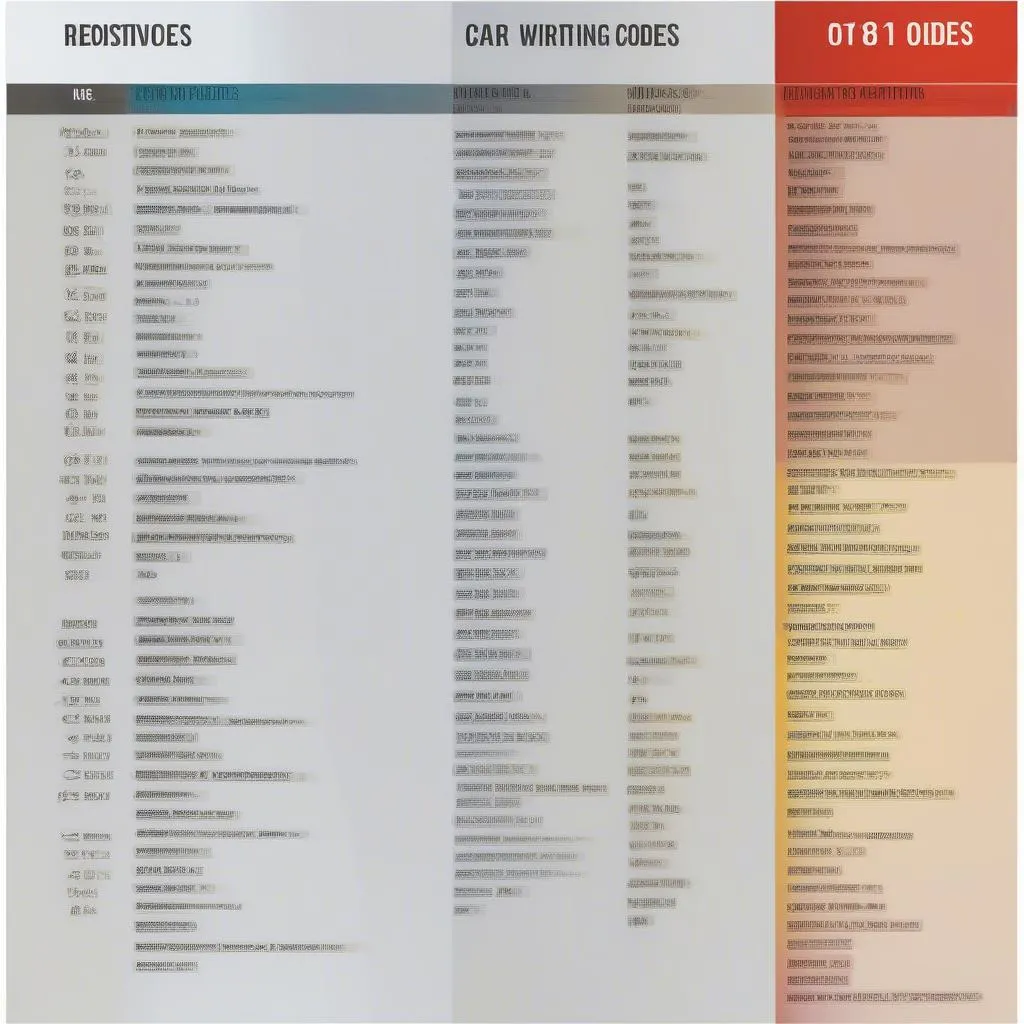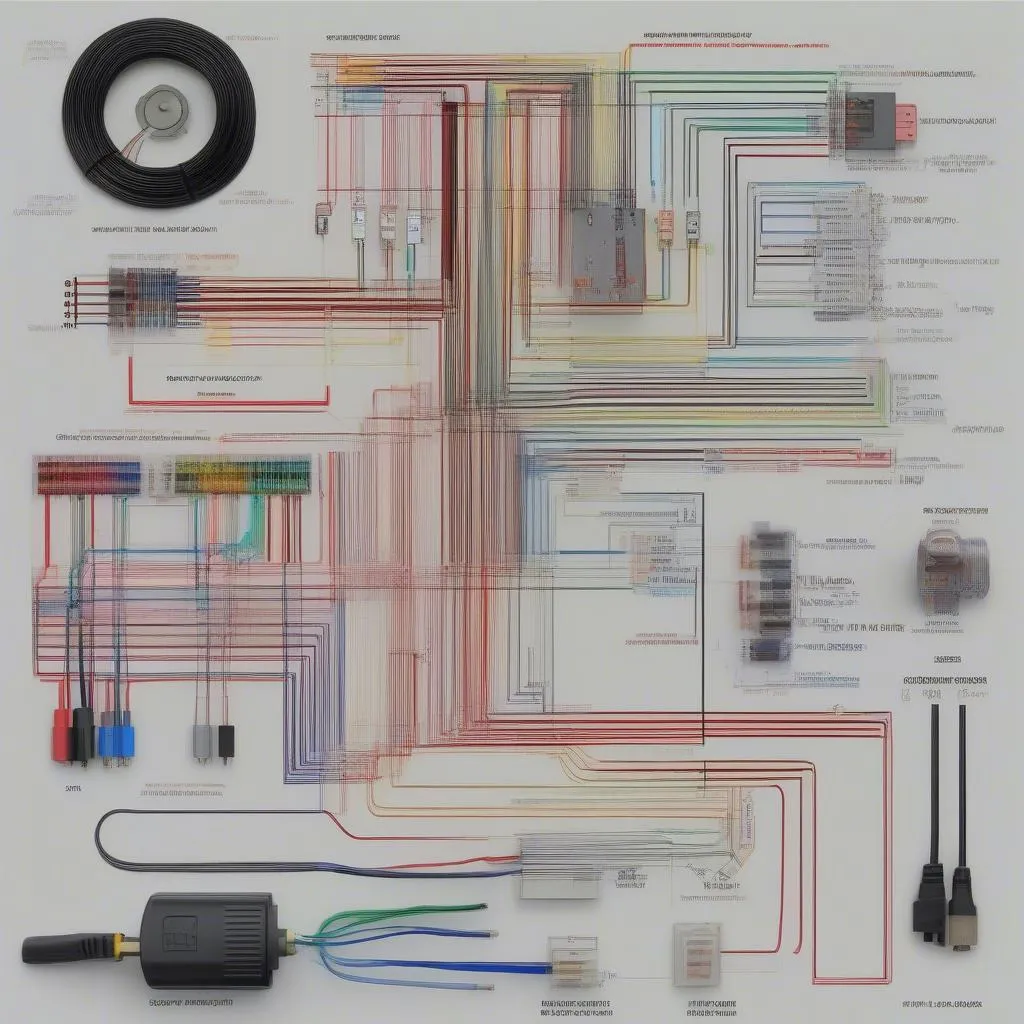You’re working on a DIY project for your car, and you stumble upon a wiring diagram with a plethora of colorful wires. You’re probably thinking, “What does each color mean?” Well, you’re not alone. Many car owners find themselves perplexed by the seemingly random color combinations used in car wiring systems.
Today, we’re going to demystify the world of Car Wiring Color Codes. We’ll explore why color codes are used, what they represent, and how to interpret them effectively.
Understanding the Importance of Car Wiring Color Codes
Car wiring color codes are not arbitrary. They’re a standardized system designed to ensure consistency and safety. Think about it like this: Imagine trying to assemble a complex jigsaw puzzle without any clues. It would be a daunting task! Similarly, a car’s electrical system relies on the color codes to guide technicians, mechanics, and even DIY enthusiasts like you.
Why are color codes used in car wiring?
- Organization: Car wiring systems are intricate, involving numerous wires connected to various components. Color codes provide a visual organization, making it easier to identify individual circuits and their connections.
- Efficiency: Technicians can quickly identify wires based on their colors, saving time and effort during repairs or modifications. This efficiency also translates to faster and more accurate diagnoses.
- Safety: Consistent color coding minimizes the risk of accidental misconnections, which could lead to electrical malfunctions or even fire.
Decoding the Color Codes: What They Mean
Car wiring color codes are standardized by the Society of Automotive Engineers (SAE), but they can differ slightly between manufacturers and models. Here are some common color codes and their associated functions:
Common Car Wiring Color Codes and their meanings:
- Black: Usually indicates ground or negative terminal. This color represents the return path for electricity.
- Red: Typically represents a positive terminal, carrying power from the battery or alternator.
- White: Often indicates a ground or negative terminal, especially for body grounds.
- Yellow: Frequently used for turn signal or hazard light circuits.
- Green: Often associated with ignition circuits, especially for starter wires.
- Blue: Generally used for high-speed data lines, like those found in CAN bus systems.
- Brown: Often represents a switched hot wire, meaning that power flows through the wire when a specific switch or relay is activated.
- Orange: Often used for indicator or warning lights.
- Purple: Frequently used for radio antenna wiring.
Important Considerations:
- Multiple Wire Colors: Some wiring systems may use multiple colors to identify specific circuits. For example, a wire may be red with a white stripe, indicating a switched positive terminal.
- Manufacturer Differences: While the SAE sets standards, car manufacturers may deviate slightly, especially with newer models.
- Wiring Diagrams: Always consult a wiring diagram specific to your vehicle’s make, model, and year for the most accurate information.
Example: A common scenario
“I’m trying to install a new stereo in my 2018 Honda Civic. The wiring diagram shows a red wire with a white stripe for constant power and a black wire for ground. I can confidently connect these wires to the stereo based on the color code!”
Finding the Wiring Diagram for Your Car
You can find wiring diagrams for your car online, in service manuals, or at auto parts stores. Some websites provide free wiring diagrams, while others require a subscription.
Here’s a helpful tip: Many online resources use a specific format like “YEAR – MAKE – MODEL – OBD PORT WIRING DIAGRAM”. Search for these terms to find the correct wiring diagram for your car.
What other questions do people have about Car Wiring Color Codes?
Q: Are there any universally recognized color codes for car wiring?
A: While the SAE sets standards, some manufacturers may use their own variations. It’s always best to consult a wiring diagram specific to your car’s make, model, and year.
Q: How can I tell if a wire is positive or negative?
A: You can use a multimeter to test the voltage of a wire. A positive wire will show a positive voltage reading, while a negative wire will show a negative or zero voltage reading.
Q: Can I use a different color wire if I need to replace a damaged wire?
A: It’s not recommended to change the color of a wire unless you’re replacing it with a matching color from the manufacturer. Changing the color can lead to confusion and potentially dangerous misconnections.
Q: What if I’m working on a classic car or an older model?
A: Older cars may not follow the same SAE standards as newer models. It’s essential to consult wiring diagrams specific to your car’s year of manufacture.
Q: Are there any resources I can use to learn more about car wiring?
A: Yes! Many online resources provide detailed information about car wiring, including wiring diagrams, color code guides, and troubleshooting tips.
Conclusion
Understanding car wiring color codes is crucial for anyone working on their vehicle’s electrical system. While there are general standards, it’s important to consult a wiring diagram specific to your car for accurate information. Always prioritize safety and double-check your connections before applying power.
Don’t hesitate to leave a comment below if you have any further questions or share your experience with car wiring color codes! You can also discover more valuable insights about automotive electrical systems on our website, Tech Car USA.
 Wiring Color Codes
Wiring Color Codes
 Wiring Diagram
Wiring Diagram
Need expert assistance with your car’s electrical system? Contact us at Whatsapp: +84767531508 for professional support and guidance. Our team of certified automotive technicians is available 24/7 to help you troubleshoot, diagnose, and repair any electrical issues.